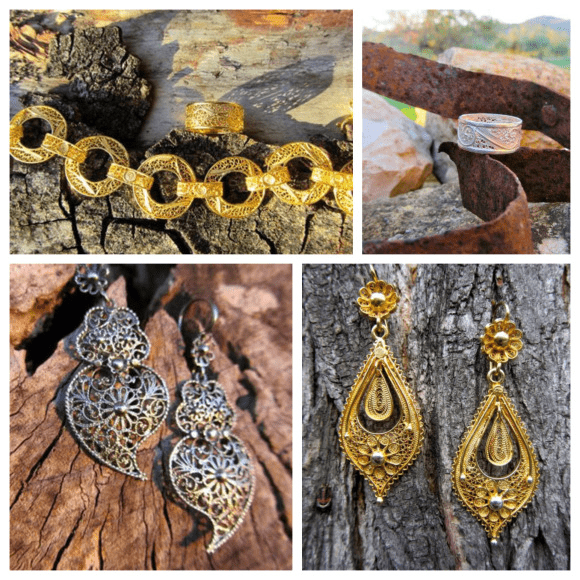One of my favorite things to come out of Portugal is filigree. If you don’t already know, filigree is “a delicate kind of jewellery metalwork, usually of gold and silver, made with tiny beads or twisted threads, or both in combination, soldered together or to the surface of an object of the same metal and arranged in artistic motifs” (thanks, Wikipedia). So what makes filigree so special and why do you need it in your life?
I was lucky enough to watch artisans at work in a real filigree studio. They often start learning in their teens and become masters in the art by their 20s. It’s incredible how much detail goes into this art form: each tiny piece of silver or gold wire is individually curled and inserted by hand!
Why do I love it so much? First of all, filigree is so versatile! I’ve seen all types of filigree jewelry items – necklaces, rings, bracelets, brooches, earrings and cufflinks – but I’ve also seen trinket boxes, lighter cases (for smokers who want to add a touch of sophistication to their smoke breaks) and even this little treasure: a small prayer book from 1926 covered in filigree. Everything is just prettier when covered in silver and gold swirls, hearts and flowers.

Another reason why you need filigree in your life is that it’s so timeless. It’s been around for hundreds of years and can be worn with casual attire or at special occasions. In fact, in northern Portugal, brides traditionally wore a lot of filigree on their wedding day. Even Sharon Stone agrees that filigree is still cool.

Amongst all the lovely beads, hearts and flowers, a seemingly random (to non-Portuguese people, anyway) recurring filigree theme is a caravel (caravela), a small Portuguese sailing vessel. I can only assume it’s a celebration of our maritime history, but they actually make a superb gift for someone who’s into sailing and “already has everything”.

Now the bad part: Portuguese filigree is a dying art form! It saddens me so much that filigree is at risk of “extinction” due to several factors: 1) an environment where consumers demand low costs for products, often at the expense of quality, 2) investment in areas that are not traditional art forms, and 3) an increasing number of young people migrating to big cities (most filigree studios/factories are in small villages or towns like Póvoa de Lanhoso).
If this saddens you too, consider buying some filigree on your next trip to Portugal. It’s makes an amazing (and unusual) gift for a loved one, and it’s a souvenir you’ll actually use. But please, do yourself – and these talented artisans – a favor: don’t buy the cheap imitations! The real product will be stamped on the actual silver, gold, or gold-plated silver, and will last you longer than a week or two. Reputable jewelers in downtown Lisbon (on Rua do Ouro or Rua da Prata) will have a great selection to choose from. If you’re going elsewhere in the country, comment below and I’ll make it my mission to find a jewelry store that sells filigree near you!




[…] For more information on filigree jewelry, check out my previous collab with Petite Moda, and my post on the art of filigree. […]